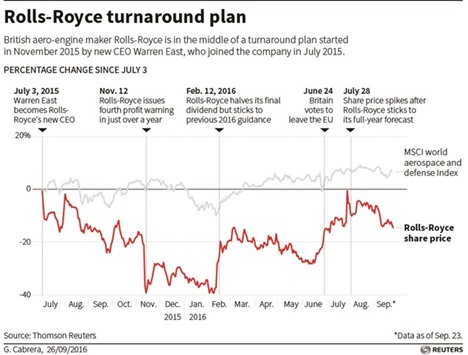Rolls-Royce boss Warren East has rebuilt confidence in the British engine-maker, but there are doubts among investors and industry experts about whether his slimmed-down group has the muscle to meet ambitious production and development goals.
The CEO has axed more than 600 management jobs and sought to reduce production times and costs since taking the helm last July, as part of a drive to increase efficiency at a company traditionally viewed as a symbol of British engineering might.
While wrestling with the restructuring, however, Rolls must almost double its output of wide-body plane engines by 2019 to meet orders.
It must also replace the blades across hundreds of engines used in Dreamliners after some cracked, while designing two new jet engines, the Advance and UltraFan.
A source in the company familiar with its strategy told Reuters that East’s turnaround programme was being felt across the business.
It has eliminated 33 internal legal entities out of about 300, allowing it to cut down on back office support and internal transactions, the source said.
There has also been progress on the factory floor, according to the source.
At one plant in Washington, northeast England, he said Rolls had cut the time it takes to manufacture the fan and turbine discs used in its engines by 50%, by combining production processes and introducing robotics and faster inspection processes.
East has also been shaking up the senior executive team tasked with turning around the aerospace and defence company, naming Daily Mail and General Trust’s Stephen Daintith as its new finance chief last week.
The company also told Reuters that it has appointed mergers and acquisitions banker Ben Story as director of strategy and marketing and Neil Crockett, a former veteran of Cisco Systems Inc, as chief digital officer.
His overhaul has buoyed the company’s stock, along with the impact of the fall in the pound against the dollar after the Brexit vote, which makes Rolls engines cheaper for overseas buyers. Rolls-Royce shares are up 25% this year. But even some of its most supportive investors concede that, while the restructuring — which included axing a fifth of senior management jobs — might stand Rolls in good stead in the long term, it could pose problems over the next five years.
“There are plenty of uncertainties out there.
And if you focus on those, it could be a pretty bumpy ride,” said senior portfolio manager Kave Sigaroudinia at Baillie Gifford, Rolls’s fourth-biggest shareholder, according to Thomson Reuters data.
“You will get operational challenges, ramping up production can create operational problems,” Sigaroudinia told Reuters. A spokesman for Rolls-Royce, which issued a string of profit warnings last year, said the company was focused on making the business simpler and more efficient.
“We can continue to be focused on our transformation, even while we increase engine production and invest in the new technologies that will create the next generation of Rolls-Royce civil aerospace engines,” he added.
Analysts expressed deeper concerns about the company, whose shares trade at a price to earnings ratio of 27 for 2016, compared with a sector average of in the mid-teens. That comes despite an expected halving of profits this year and no recovery to 2015’s profit level in sight for the next three years.
Of 24 analysts covering the stock, only two rate it a “strong buy” or a “buy”, while its current 711 pence share price trades well above the consensus 627 pence target price, according to Reuters data.
“Rolls looks to be priced almost for a flawless execution,” said Barclays analyst Phil Buller, who has an underweight rating on the stock with a target price of 480 pence.
East, 54, is one of the most celebrated technology executives in Britain, having built ARM into the country’s most successful tech company in the 12 years he was CEO.
But flawless execution is particularly hard to come by in the aviation industry, where the giant nature of projects mean they are regularly subject to cost-overruns and delays.
At the same time as almost doubling its wide-body jet engine output, Rolls is looking at squeezing more out of its Trent XWB engine for the Airbus A350 engine by enhancing it for a potential, bigger 400-seat model of the plane, as Airbus and Boeing play leapfrog in the market for twinjets.
Any problem with the availability of parts — and there are over 20,000 in each Trent XWB — or issues with quality could delay the ramp up programme. It is also developing a derivative of the Trent 1000 for another Airbus jet, the A330neo.
That is on top of the new Advance and UltraFan engines for wide-body jets — to be ready for service in 2020 and 2025 respectively. “The CEO acknowledged that existing engineering resources are ‘stretched’ against this set of programmes,” Bernstein analysts said after East participated in their conference this month.


